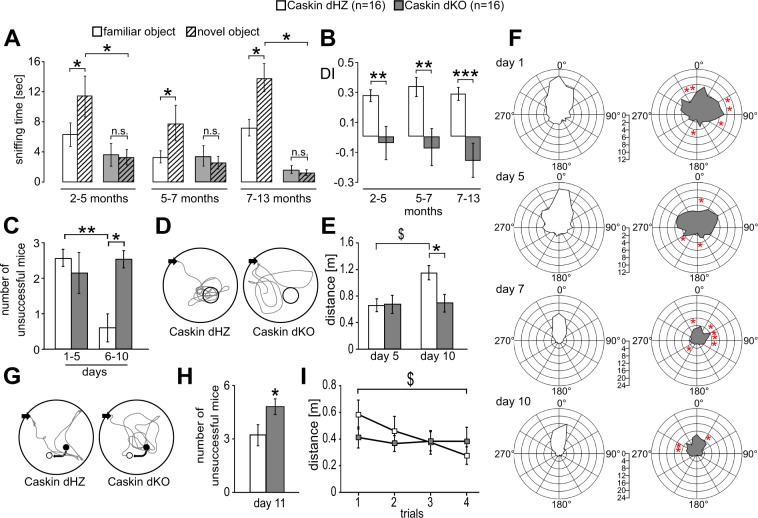Figure 2.
Deletion of Caskin1 and Caskin2 genes impairs novel object recognition and spatial memory when comparing Caskin double heterozygous (Caskin dHZ, designated by white colour; n = 16) and Caskin double knockout (Caskin dKO, designated by grey colour; n = 16) mice. (A,B) Novel object recognition tests performed at different developmental ages, indicating (A) the average sniffing time what Caskin dHZ (columns with white background) and dKO (columns with grey background) mice spent at the familiar (A1; empty columns) or novel (B; striped columns) objects in the 2nd round of novel object recognition test, performed after 5 hours. (B) Discrimination index showing the relative preference towards the novel object (DI; see Materials and Methods) was significantly lower in Caskin dKO mice, regardless of their developmental age. (C–I) Morris water maze test results of Caskin dHZ and Caskin dKO mice. (C) Average number of failures during day 1–5 and 6–10. (D) Representative trajectories from Caskin dHZ and Caskin dKO mice during the second probe trial of the Morris water maze (day 10). Black arrows indicate start positions; circles represent the target area over the original platform. (E) Average swimming path length above the removed platform during the probe trials on day 5 and 10. (F) Average angle preference values of Caskin dHZ and Caskin dKO mice obtained on day 1, 5, 7 and 10. (G–I) On day 11, the platform was moved from its original position (filled circle) into an adjacent quadrant (open circle) (G). Black arrows indicate the start position of the swimming trajectories. (H) Average number of failures to find the relocated platform. (I) Average swimming path length during four consecutive trials on day 11. All data are shown as mean ± SEM. Asterisks represents significance compared to control values (white columns), $ indicates significant differences between data pairs. $p < 0.05; *p < 0.05; **p < 0.01; ***p < 0.001.

